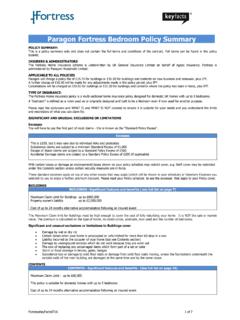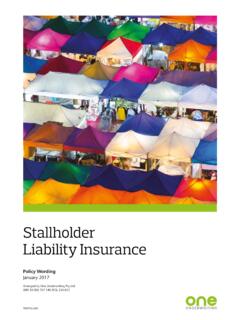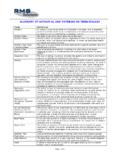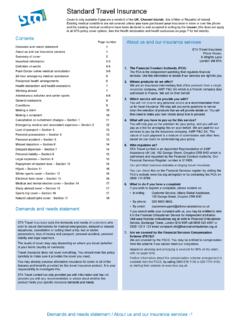Transcription of FIRA - Summary of Coverage - FloodSmart Insurance
1 FEMA National Flood Insurance Program Summary of Coverage This document was prepared by the National Flood Insurance Program (NFIP) to help you understand your flood Insurance policy . It provides general information about deductibles, what is and is not covered by flood Insurance , and how items are valued at time of loss. This document is based on the Standard Flood Insurance policy Dwelling Form, which is used to insure one to four family residential buildings and single family dwelling units in a condominium building. There are two other policy forms: The General Property Form is used to insure five or more family residential buildings and non-residential buildings.
2 The Residential Condominium Building Association policy Form is used to insure residential condominium association buildings. While the three forms are similar in many ways, there are differences as well. For example, the General Property Form does not provide Coverage for contents in any building other than the insured building, and the Residential Condominium Building Association policy Form contains a coinsurance clause, which provides for a pro rata reduction in the building claim payment if the building is not insured to 80 percent of its replacement value.
3 TTwoTypesofFlloodInsuranceCoverageThe NFIP's Dwelling Form offers Coverage for: 1. Building Property, up to $250,000, and 2. Personal Property (Contents), up to $100,000. The NFIP encourages people to purchase both types of Coverage . Your mortgage company can require that you purchase a certain amount of flood Insurance Coverage . Forinformattionaboutyouurspecificllimits ofcoverageanddeductibles, is a Flood? Flood Insurance covers direct physical loss caused by flood. In simple terms, a flood is an excess of water on land that is normally dry.
4 Here s the official definition used by the National Flood Insurance Program. A flood is A general and temporary condition of partial or complete inundation of two or more acres of normally dry land area or of two or more properties (at least one of which is your property) from: Overflow of inland or tidal waters; Unusual and rapid accumulation or runoff of surface waters from any source; Mudflow*; or Collapse or subsidence of land along the shore of a lake or similar body of water as a result of erosion or undermining caused by waves or currents of water exceeding anticipated cyclical levels that result in a flood as defined above.
5 *Mudflow is defined as A river of liquid and flowing mud on the surfaces of normally dry land areas, as when earth is carried by a current of Three Important Facts About Your Flood policy A Standard Flood Insurance policy is a single-peril (flood) policy that pays for direct physical damage to your insured property up to the replacement cost or Actual Cash Value (ACV) (See How Flood Damages Are Valued ) of the actual damages or the policy limit of liability, whichever is less. 1. Contents Coverage must be purchased separately.
6 2. It is not a valued policy . A valued policy pays the limit of liability in the event of a total loss. For example: Your home is totally destroyed by a fire and it costs $150,000 to rebuild. If your homeowners Insurance policy is a valued policy with a $200,000 limit of liability on the building, you would receive $200,000. Flood Insurance pays just the replacement cost or ACV of actual damages, up to the policy limit. 3. It is not a guaranteed replacement cost policy . A guaranteed replacement cost policy pays the cost to rebuild your home regardless of the limit of liability.
7 For example: Your home is totally destroyed by a fire and it costs $200,000 to rebuild. If your homeowners Insurance policy is a guaranteed replacement cost policy with a $150,000 limit of liability on the building, you would receive $200,000. Flood Insurance does not pay more than the policy limit. 1 FloodSmart Insurance Inc. 866-277-0055 Choosing Deductibles Choosing the amount of your deductibles is an important decision. As with car or homeowners Insurance , choosing a higher deductible will lower the premium you pay, but will also reduce your claim payment.
8 You can normally choose different deductibles for Building Property and Personal Property Coverage . The deductibles will apply separately to Building Property and Personal Property claims. Your mortgage company can require that your deductible is no more than a certain amount. Review the Declarations Page in your flood Insurance policy for amounts of Coverage and deductibles. Talk with your Insurance agent, company representative, or lender about raising or lowering deductibles. Remindder:KeepYouurReceiptsWhile you are not expected to keep receipts for every household item and article of clothing, do try to keep receipts for electronic equipment, wall-to-wall carpeting, major appliances, and other higher cost items.
9 Your adjuster will be able to process your claim more quickly when you can prove how much items cost at the time of purchase. What is Covered by Flood Insurance and What s Not Generally, physical damage to your building or personal property directly caused by a flood is covered by your flood Insurance policy . For example, damages caused by a sewer backup are covered if the backup is a direct result of flooding. However, if the backup is caused by some other problem, the damages are not covered. The following charts provide general guidance on items covered and not covered by flood Insurance .
10 Refer to your policy for the complete list. GeneralGuidanceonnFloodInsurranceCoverag geWhatisinssuredunderBBuildingProopertyc overrage The insured building and its foundation. The electrical and plumbing systems. Central air conditioning equipment, furnaces, and water heaters. Refrigerators, cooking stoves, and built-in appliances such as dishwashers. Permanently installed carpeting over an unfinished floor. Permanently installed paneling, wallboard, bookcases, and cabinets. Window blinds. Detached garages (up to 10 percent of Building Property Coverage ).







